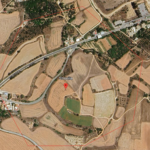Understanding how living heritage persists in contested spaces requires a research approach that goes beyond textual analysis. Strovilia, with its fragmented political landscape and near-total depopulation, presents a unique case study for examining how cultural memory, communal spaces, and documentation contribute to heritage resilience. To explore this, my research follows a qualitative and participatory methodology, integrating archival research, semi-structured interviews, and memory mapping to uncover how Strovilia’s cultural heritage is remembered, interpreted, and potentially reimagined.
Research Questions
At the core of this study is the question:
How does living heritage persist in contested spaces (despite political fragmentation and depopulation)?
This overarching inquiry is further explored through sub-questions:
- How have the overlapping jurisdictions (Republic of Cyprus, TRNC, British SBA) influenced the cultural landscape and heritage practices of Strovilia?
- What role do Strovilia’s church and coffee shop play as cultural memory anchors, and how do former and current residents narrate their significance?
- Can living heritage remain resilient through documentation, and what are the challenges and limitations of this process?
Methodological Framework
To answer these questions, my research employs a qualitative and participatory approach that aligns with my project’s objective of capturing the lived experience of Strovilia’s heritage. The study integrates archival research, semi-structured interviews, and memory mapping to create a layered understanding of cultural resilience.
- Archival & Visual Documentation
Establishing a historical foundation is crucial for contextualizing heritage loss and transformation. I will collect historical documents, maps, photographs, and administrative records related to Strovilia’s communal spaces, particularly the church and coffee shop, to analyze their historical significance and spatial evolution. This will be complemented by on-site visual documentation of the current condition of key locations. - Semi-Structured Interviews with Embedded Memory Mapping
Oral histories are at the core of this study. Interviews with current and former residents will provide firsthand perspectives on the social and cultural functions of heritage spaces, the challenges of preservation, and the role of documentation in sustaining memory. To enhance these interviews, I will integrate memory mapping, asking participants to mark key locations on maps while narrating their significance. This method ensures a spatial and visual representation of cultural memory, revealing how places are remembered, even in the absence of physical continuity. - Thematic & Spatial Analysis
To process the collected data, I will use thematic analysis to identify recurring narratives in interviews and spatial analysis to compare memory maps with archival materials. This will allow me to examine how spaces are remembered, how they have changed, and whether documentation alone can sustain cultural resilience.
Justification and Anticipated Challenges
This methodological approach balances rigor, feasibility, and engagement. Conducting memory mapping within interviews reduces the need for separate mapping sessions, while also encouraging participants to actively engage with their own histories. However, challenges remain, including navigating the ethical complexities of working with oral histories in a politically contested space. Ensuring informed consent, data protection, and cultural sensitivity will be critical as I move forward.
C.C.


